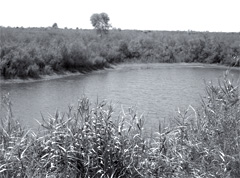Pacific Southwest, Region 9
Serving: Arizona, California, Hawaii, Nevada, Pacific Islands, 148 Tribes
Cocopah’s Efforts to Restore the Lower Colorado River Limitrophe

The Limitrophe is the segment of the Lower Colorado River that serves as the international boundary between the U.S. and Mexico, and divides the Cocopah from their Cucapá relatives in the Baja California delta region.
For many centuries, the Cocopah, known as the River People, lived in harmony with the mighty Lower Colorado River Delta region, one of the largest tidal wetlands in the world. Today, the river is among North America's top ten most endangered rivers (American Rivers organization, 1998), and the Cocopah Indian Nation is leading efforts to restore the highest conservation priority area in the delta region: the Lower Colorado River Limitrophe.
The Limitrophe is the segment of the Lower Colorado River that serves as the international boundary between the U.S. and Mexico, and divides the Cocopah from their Cucapá relatives in the Baja California delta region. On the U.S. side, 12 miles of the 23 mile Limitrophe are on the Cocopah Indian Reservation, and 10 miles are on Bureau of Reclamation land. In a 2005 report, the Limitrophe was identified as the top conservation priority in the delta by the Sonoran Institute, Environmental Defense, University of Arizona, Centro de Investigacion en Alimentacion y Desarrollo, Pronatura Sonora and World Wildlife Fund.
With funds from EPA, the Bureau of Indian Affairs and the Bureau of Land Management Reclamation (BORLM), the Cocopah Indian Nation restored over 200 acres of riparian habitat in the Limitrophe by removing stands of invasive salt cedar and restoring native cottonwood, willow and mesquite. The tribe is also restoring another 150 acres, with funds from the Department of Homeland Security (DHS), the U.S. Fish and Wildlife Service, and the National Fish and Wildlife Foundation. DHS supports salt cedar removal because it opens up corridors which enhance security operations along the border.
These restoration efforts coincide with other efforts in the area, most notably the City of Yuma's East and West Wetlands Project conducted in partnership with the Quechan Indian Nation. That project restored 1,500 acres upstream of the Limitrophe, with nearly half of the restored acres on the Quechan Indian Nation's reservation.
Opportunities exist to expand restoration of the Limitrophe. In December 2006, the BLM issued a draft Environmental Impact Statement proposing creation of a Limitrophe Coordinated Management Area (CMA) for BOR's 4500 acres along the Limitrophe. The proposed Limitrophe CMA would protect and maintain riparian habitat and marsh vegetation, as well as enhance the characteristics of the Limitrophe area identified by the Cocopah and other tribes as important for traditional uses.
Together, the Cocopah Indian Nation and the National Wildlife Federation (NWF) formed the Colorado River International Conservation Area (CRICA) steering committee to secure permanent cultural and biological resource protection for the Limitrophe area in the U.S. and Mexico and to secure adequate water flows for wildlife and habitat protection. The CRICA unites diverse stakeholders from over 20 non-governmental organizations and local, state, and federal agencies from the U.S. and Mexico.
Restoring the Limitrophe is part of a much larger binational effort to protect the lower Colorado River and Delta region. In 1993, the Mexican government designated 2.3 million acres of the upper Gulf of California and the Colorado River Delta as a Biosphere Reserve. The goal of some organizations is to create a binational conservation area, extending from the Limitrophe to the biosphere preserve. With the aid of current and future projects, the Colorado River can be restored and protected for generations to come.
Extracted From
Border 2012: U.S.-Mexico Environmental Program
Arizona/Sonora Regional Workgroup
Regional Workgroup Newsletter
Spring 2007 (PDF) (12 pp, 1.8MB, About PDF)
En Espanol - Boletín Del Grupo De Trabajo Regional (PDF) (12 pp, 2.1MB, About PDF)
For more information
Linda Reeves (reeves.linda@epa.gov)
(415) 9273445
